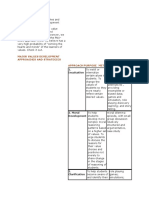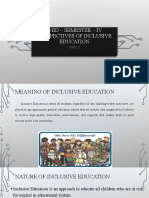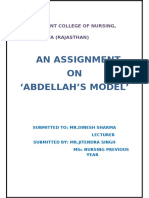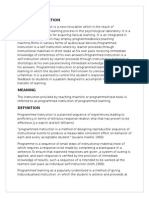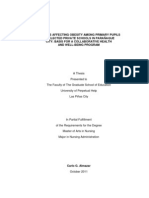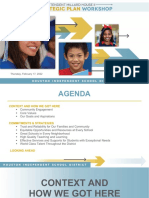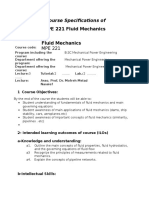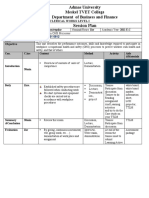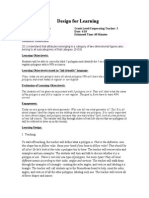Professional Documents
Culture Documents
A Study To Assess The Effectiveness of Self Instructional Module Regarding Dyslexia and Davis Dyslexia Correction Method Among Primary School Teachers in Selected Schools at Bangalore, Karnataka.
Original Title
Copyright
Available Formats
Share this document
Did you find this document useful?
Is this content inappropriate?
Report this DocumentCopyright:
Available Formats
A Study To Assess The Effectiveness of Self Instructional Module Regarding Dyslexia and Davis Dyslexia Correction Method Among Primary School Teachers in Selected Schools at Bangalore, Karnataka.
Copyright:
Available Formats
Volume 6, Issue 6, June – 2021 International Journal of Innovative Science and Research Technology
ISSN No:-2456-2165
A Study to Assess the Effectiveness of Self
Instructional Module Regarding Dyslexia and Davis
Dyslexia Correction Method among Primary School
Teachers in Selected Schools at
Bangalore, Karnataka.
Visanth V S,
Professor, Sherwood College of Nursing, Barabanki, Uttar Pradesh
Abstract:- Dyslexia refers to a difficulty in learning to Objectives of the study
read in a person who has good intelligence, strong 1. To assess the knowledge of primary school teachers
motivation, and who has received appropriate teaching. regarding dyslexia and Davis dyslexia correction method
School teachers can easily identify and take corrective in terms of pretest knowledge scores.
measures for this type of learning disorders. By 2. To determine the effectiveness of self-instructional
considering this the researcher investigates the module regarding dyslexia and Davis dyslexia correction
effectiveness of self- instructional module regarding method by comparing the pretest and posttest scores.
dyslexia and Davis dyslexia correction method among 3. To associate the pretest knowledge regarding dyslexia
the primary school teachers. The study was conducted and Davis dyslexia correction method among the
among primary school teachers at Bangalore. Pre- primary school teachers with their selected demographic
experimental one group pre-test post-test design is used variables.
and the data collection is done by structured knowledge
questionnaire. Research Hypothesis
H1: There is a significant difference between the mean pre-
The paired t-test was carried out and it was found test and post-test knowledge scores.
to be invariably significant at P< 0.05 level. It is evident H2: There is a significant association between pre-test
that the Self Instructional Module is significantly knowledge scores with selected demographic variables.
effective on improving the knowledge regarding dyslexia
and Davis Dyslexia correction method among primary II. CONCEPTUAL FRAMEWORK
school teachers.
Concepts are images, abstracts, picture or mentally
Keywords:- Effectiveness, Self-Instructional Module, formed real world observation of things, objects or events
Dyslexia, Davis Dyslexia Correction Method, Knowledge, that an individual experiences. A conceptual model or
Primary School Teacher. conceptual framework broadly explains phenomena of
interest, expresses assumption and reflects a philosophical
I. INTRODUCTION stance.
As soon as the children enter the school, a key goal is The conceptual framework is developed by the
learning to read, to enable lifelong reading to learn. investigator based on Imogene King’s goal attainment
Teachers accept this as one of their key roles and can theory. According to Imogene King “If nurse are to assume
receive training and resources to help in this endeavor. the role and responsibilities expected of them, the discovery
Dyslexia is one of the most widely known learning of knowledge, the system as a whole and all activities can be
difficulties. 5These children have problems differentiating resolved into aggregation of circuits such as interaction,
between “b/d, j/g, 21/12” as well as problem reversing such perception and transaction.”
letters. A person may read the word, "lice," as, "ice" or as,
"like." The person may realize that these are incorrect, but Perception: Perception is ‘each person’s representation of
cannot read those words correctly. Some dyslexics do better reality”. In this study, it refers to the exploring information,
by moving their finger along the outline of a word or, by energy and transforming by assessing the pre-test and post-
tracing the letters in the air. test knowledge of the primary school teachers regarding
dyslexia and Davis dyslexia correction method.
IJISRT21JUN204 www.ijisrt.com 182
Volume 6, Issue 6, June – 2021 International Journal of Innovative Science and Research Technology
ISSN No:-2456-2165
Judgment: It refers to the ability to form sound opinions In this study reaction includes assessment of knowledge
and make sensible decisions or reliable guesses about any using structured knowledge questionnaire.
situation in a particular situation or event.
Interaction: Interaction is the process of perception and
Action: It refers to the process of doing something in order communication between person and environment, between
to achieve a desirable purpose. In this study action of nurse persons and person, represented by verbal and nonverbal
investigator includes formulation of suitable instructional behaviors that are goal directed. In this study, it refers to the
module for the primary school teachers. communication between the investigator and subject by
collecting basic demographic data of the individuals.
Communication: It is a process whereby information is
given from one person to another either directly or Transaction: It is an observable behavior of human beings
indirectly. interacting with that environment. Transactions represent the
valuation component of human interactions and involve
Clarification: It refers to make something clearer by bargaining, negotiating and social exchange.
explaining it in greater detail. In this study the nurse
investigator explains in detail about dyslexia and Davis Reinforcement: It refers to added support to make
dyslexia correction method. something stronger. In this study it refers to an additional
support which helps to strengthen and improve the
Reaction: It refers to a response to something that involves knowledge of the primary school teachers.
taking action, or an action taken in response to something.
III. RESEARCH METHODOLOGY O1 X O2
Pretest using Self-instructional Post-test using
Research Approach: structured module on same structured
Qualitative research approach was used to assess the questionnaire on dyslexia and questionnaire.
knowledge of school teachers regarding dyslexia and Davis dyslexia and Davis dyslexia
dyslexia correction method. Davis dyslexia correction
correction method.
Research Design: method.
Pre experimental one group pretest-post-test design is
adopted for this study Population: The total population of the study comprised of
the primary school teachers in selected schools at Bangalore
Sample: The sample size of the present study consists of 40
primary school teachers.
IJISRT21JUN204 www.ijisrt.com 183
Volume 6, Issue 6, June – 2021 International Journal of Innovative Science and Research Technology
ISSN No:-2456-2165
Sampling Technique: Non probability purposive sampling Part II: Structured knowledge questionnaire contains 24
technique was adopted to select the samples questions on knowledge regarding dyslexia and Davis
dyslexia correction method (General information about
Description of the tool dyslexia (meaning, incidence, signs and symptoms of
The tool consists of 2 sections: dyslexia) and about Davis dyslexia correction method.
Part I: Structured questionnaire for collecting demographic
data of the teachers Age, Gender, Educational qualification, Development of Self Instructional Module (SIM)
Professional experience, Religion, Marital status, Type of The Module was prepared on the basis of information
family, Place of residence and Sources of information. obtained during extensive literature. The finalized content
was in English and prepared as a Booklet.
IV. RESULTS
Objective 1: To assess the knowledge of primary school teachers regarding dyslexia and Davis dyslexia correction method
in terms of pretest knowledge scores.
TABLE.1.Percentage and frequency distribution of knowledge score before SIM N=40
Classification of Respondents
Pre test
Level of Knowledge Number Percentage
Adequate(> 75 % ) 2 5%
Moderate (51-75%) 20 50%
Inadequate (< 50%) 18 45%
The above table shows that only 2 teachers (5%) have adequate knowledge, 20 (50%) have moderate knowledge and 18
(45%) have knowledge regarding dyslexia and Davis dyslexia correction method among primary school teachers in selected
schools at Bangalore.
LEVEL OF KNOWLEDGE
5%
adequate>75%
45%
50% moderate50-75%
inadequate<50%
Figure 2: Distribution of level of knowledge before SIM.
Table 2 Overall Knowledge score before SIM
Sl: No Aspects Statements Max Score Score Knowledge Score
range Mean Mean%
SD Mean %
1. Over All 24 24 5-20 11.55 3.36 48.12%
The table 2 shows primary school teachers overall knowledge regarding dyslexia and Davis Dyslexia correction method. The
Knowledge score in overall before SIM is 11.55 in mean 3.36 in S., D 48.12% in mean percentage.
IJISRT21JUN204 www.ijisrt.com 184
Volume 6, Issue 6, June – 2021 International Journal of Innovative Science and Research Technology
ISSN No:-2456-2165
Objective 2: To determine the effectiveness of self-instructional module regarding dyslexia and Davis dyslexia correction
method by comparing the pretest and posttest scores.
Table–3: Percentage and frequency distribution of knowledge score after SIM N=40
Classification of Respondents
Post test
Level of Knowledge Number Percentage
Adequate (>75%) 33 82.5
Moderate (51-75%) 7 17.5
Inadequate (<50 %) 0 00.0
Table 3 shows that 33 (82.2%) of the teachers acquired adequate knowledge, 7 (17.5%) of the respondents had moderate
knowledge and none of the respondents had inadequate knowledge in the posttest.
Table 2 reveals that Knowledge score in overall is 20.12 in mean 2.56 in S. D 83.83% in mean percentage after SIM.
90.00%
80.00%
70.00%
60.00%
50.00%
40.00%
30.00%
20.00%
10.00%
0.00%
Moderate Adequate Inadequate
Figure: 3: Distribution of knowledge level after SIM.
Table.4 Knowledge score after SIM
Sl: No Aspects Statements Max Score Score Knowledge Score
range Mean Mean%
SD Mean % M
1. Over All 24 24 14-24 20.56 2.56 83.83%
Table 4 shows that after pretest and post-test there is 13.3% gain in knowledge, in incidence there is 38.3% gain in
knowledge, in cause 37.7% gain in knowledge in clinical manifestation there is 30.6% gain in knowledge., in management there is
40.67% gain, in correction method there is 36.43% gain and in over all there is 35.71% gain
Table 5: Gain in Knowledge after SIM
Sl: No Aspect of Maximum Pretest Posttest Gain in Mean
Knowledge Possible Score Mean Mean Score% Mean Mean Score% Score
1. Over All 24 3.36 48.12 20.12 83.83 35.71
Table 6 shows the mean pre and post -test knowledge regarding dyslexia and Davis dyslexia correction method. The paired
t-test was carried out and it was found to be significant at P< 0.05 level, hence null hypothesis (H01) is rejected and research
hypothesis (H1) was accepted. It is evident that the Self Instructional Module is significantly effective on improving the
knowledge regarding dyslexia and Davis Dyslexia correction method among primary school teachers.
IJISRT21JUN204 www.ijisrt.com 185
Volume 6, Issue 6, June – 2021 International Journal of Innovative Science and Research Technology
ISSN No:-2456-2165
Table 6: Effectiveness of SIM
Sl: No Aspect of Pre Test Post Test Paired ‘t’ P value
knowledge Mean S.D Mean S.D Value
1. Over All 11.55 3.36 20.56 2.56 12.98 P<0.05
Objective 3: To associate the pretest knowledge [4]. Vallutino. F. R, Fletcher J. M, Snowling M J. Specific
regarding dyslexia and Davis dyslexia correction method reading disability: what have we learned in the past
among the primary school teachers with their selected four decades? Journal of child psychology and
demographic variables. psychiatry, 45(1). 2004
The result of the Chi-square (χ2) analysis indicates [5]. Lee Laid Wah. Understanding dyslexia in Malaysia
that there is no significant association between knowledge from the parent’s perspective. Proceedings of Hawaii
score with selected demographic variables of primary school international conference on education university of
teachers. Hawaii, Wesh Oahu. 2004; Jan 3- 6.
[6]. Stephen M. Kosslyn and Oliver Koeuig. Wet Mind:
The association between socio-demographic variables The New Cognitive Neuroscience, New York, The
and pre-test knowledge score is observed as age (0.068), Free Press: 1990; p.185-207.
gender (0.28), educational qualification (9.07), professional [7]. Simpson, S. () ‘Dyslexia: A Developmental Language
experience (1.04), religion (1.5), marital status (0.014), type Disorder’, Child: Care, Health and Development,
of family (1.23), place of residence (0.34), and source of 2000; vol 26(5): p. 355–80.
information (2.27). [8]. URL:www.bda.dyslexia.org.uk
[9]. Gregor, P. Dickinson, A. Macaffer, A. and Andreasen,
V. CONCLUSION P. ‘SeeWord–A Personal Word Processing
Environment for Dyslexic Computer Users’, British
The overall knowledge score of primary school teachers Journal of Educational Technology, 2003; 34(3):p.
before SIM is 48.12% and after SIM is 83.13. 341–55.
It is evident that administration of SIM improves the [10]. Joshi, R. M., Dahlgren, M. and Boulware-Gooden, R.
knowledge of primary school teachers regarding dyslexia ‘Teaching Reading in an Inner City School through a
and Davis dyslexia correction method. Multisensory Teaching Approach’, Annals of
The finding of the study statistically shows that there is Dyslexia, 2002;52,:p 229–42.URL:
no significant association between the knowledge scores http://www.pubmed.com
and with the selected demographic variables at 5% level. [11]. Amos, J. ‘Promoting Dyslexia Friendliness in East
Sussex Schools’. Paper presented at the Sixth BDA
RECOMMENDATIONS International Conference, University of
Warwick:14March, 2007
1. A similar study can be undertaken by utilizing other [12]. Tsovili, T. D. ‘The Relationship Between Language
domains like attitude and practice. Teachers’ Attitudes and the State-Trait Anxiety of
2. A descriptive study may be conducted to describe all the Adolescents with Dyslexia’, Journal of Research in
aspects dyslexia and Davis dyslexia correction methods. Reading, 2004; 27(1) :p.69–86.:URL:
3. An explorative study may be conducted to identify the http://www.pubmed.com
awareness, knowledge, practice and attitude among
teacher’s regarding dyslexia and Davis dyslexia
correction methods.
4. A similar study can be conducted to identify the
awareness, knowledge, practice and attitude among
parents regarding dyslexia and Davis dyslexia correction
methods.
REFERENCES
[1]. Trieman R, Mullennie J , Bijeljac babic R. The Special
role of rimes in the description, use and acquisition of
English orthography, Journal of Experimental
psychology, General 124,7-136, 1995.
[2]. OECD, Equally Prepared for Life? How 15 year old
boys and girls perform in school (OECD, Paris 2009)
[3]. Sanders.M (2001), Understanding Dyslexia and the
Reading process. Needham heights, MA: Allyn and
Bacan.
IJISRT21JUN204 www.ijisrt.com 186
You might also like
- The Impact of Social AnxietyDocument3 pagesThe Impact of Social AnxietyJess JessNo ratings yet
- Unit-2 Concepts of Sociology PDFDocument11 pagesUnit-2 Concepts of Sociology PDFnehaNo ratings yet
- NAAC's Role in Quality AssuranceDocument4 pagesNAAC's Role in Quality Assuranceabhi0704No ratings yet
- 12 ConclusionDocument30 pages12 Conclusionbittu kumarNo ratings yet
- Values IntegrationDocument3 pagesValues IntegrationFroy Ralph CorpuzNo ratings yet
- Compiled Teanage PregnancyDocument101 pagesCompiled Teanage PregnancyShekhar SunthaNo ratings yet
- Study Habits of Secondary School Students As Related To Family EnvironmentDocument3 pagesStudy Habits of Secondary School Students As Related To Family EnvironmentJo MomNo ratings yet
- PROGRESSIVISMDocument16 pagesPROGRESSIVISMMary Ann Rodil ManaloNo ratings yet
- Field Study 1: University of Caloocan CityDocument7 pagesField Study 1: University of Caloocan CityLovelyn MaristelaNo ratings yet
- GIFTEDNESSDocument19 pagesGIFTEDNESSJohann Gabriel Abellon100% (1)
- Research Paper Chapter 1-2Document16 pagesResearch Paper Chapter 1-2Sherene UmpiaNo ratings yet
- Dorothy Johnson PosterDocument1 pageDorothy Johnson Posterapi-519455077No ratings yet
- Idealism and CurriculumDocument2 pagesIdealism and CurriculumVal Daryl AnhaoNo ratings yet
- Meaning of Educational AgencyDocument3 pagesMeaning of Educational AgencyGelgel Decano100% (1)
- A Report On Philosopical & Theological Dimensions inDocument39 pagesA Report On Philosopical & Theological Dimensions inyejjey14No ratings yet
- Group Dynamics.. FinalDocument11 pagesGroup Dynamics.. FinalPatel Amee100% (1)
- Eps 402 Notes-1Document35 pagesEps 402 Notes-1Jared MutindaNo ratings yet
- Learning Styles and Communicative CompetenceDocument14 pagesLearning Styles and Communicative CompetenceRenelyn Rodrigo SugarolNo ratings yet
- Module 20 Edcon3Document8 pagesModule 20 Edcon3Myra Belle Manlagnit100% (1)
- The Impact of Leadership On School Culture & Students Achievements.Document13 pagesThe Impact of Leadership On School Culture & Students Achievements.Les Sirc100% (2)
- Understanding Childhood AssessmentDocument14 pagesUnderstanding Childhood AssessmentJamie Villanueva Canauay100% (1)
- Research 1Document5 pagesResearch 1Tina Cidro LadiaoNo ratings yet
- Educ 111 - Arnold GesellDocument3 pagesEduc 111 - Arnold Gesellapi-356218960No ratings yet
- Facebook Addiction and Academic Anxiety Among University StudentsDocument16 pagesFacebook Addiction and Academic Anxiety Among University StudentsLawson SohNo ratings yet
- Factors Influencing The Students Academic Performance in Secondary Schools in India PDFDocument25 pagesFactors Influencing The Students Academic Performance in Secondary Schools in India PDFLyth LythNo ratings yet
- Education ManifestoDocument5 pagesEducation Manifestoapi-456524439No ratings yet
- Learner-Centered Progressivism PhilosophyDocument7 pagesLearner-Centered Progressivism PhilosophyVillamor Lanas Jhon LloydNo ratings yet
- Instructional DesignsDocument4 pagesInstructional DesignsDipti PunjalNo ratings yet
- Selection and Organization of Learning Experience SamDocument27 pagesSelection and Organization of Learning Experience SamDiksha chaudharyNo ratings yet
- Basics of Educational TechnologyDocument20 pagesBasics of Educational TechnologyPRABHAKAR REDDY TBSF - TELANGANANo ratings yet
- Vedic EducationDocument14 pagesVedic EducationshylajaNo ratings yet
- Theories in Child DevelopmentDocument15 pagesTheories in Child DevelopmentDomer RegisNo ratings yet
- Module 2: Lesson 2: Name: Crs/yr/SecDocument6 pagesModule 2: Lesson 2: Name: Crs/yr/SecJa-Cy R4o15se04ro100% (1)
- Inclusive Education Unit 1Document39 pagesInclusive Education Unit 1anitha sNo ratings yet
- Philosophies of EducationDocument37 pagesPhilosophies of EducationZaira M. TorresNo ratings yet
- Curriculum Development PDFDocument6 pagesCurriculum Development PDFJennie Rose Florita Baterna100% (1)
- Principles of Growth & DevelopmentDocument3 pagesPrinciples of Growth & DevelopmentRizza Bello ˚͜˚100% (2)
- The Parenting Style and The Academic Performance of Grade 6 Pupils of Saint Mary'S College of CatbaloganDocument24 pagesThe Parenting Style and The Academic Performance of Grade 6 Pupils of Saint Mary'S College of CatbaloganVincent Nalazon-Caranog Pamplina-ArcallanaNo ratings yet
- A Correlative Study of Academic Resilience and Academic Achievement in English Medium Secondary Students of AurangabadDocument7 pagesA Correlative Study of Academic Resilience and Academic Achievement in English Medium Secondary Students of AurangabadAnonymous CwJeBCAXpNo ratings yet
- The Teaching Profession: ProgressivismDocument21 pagesThe Teaching Profession: ProgressivismEljum Christian Guarnes100% (1)
- Aim of EducationDocument17 pagesAim of EducationAmala Antonititta AntonitittaNo ratings yet
- Evaluation ToolsDocument11 pagesEvaluation Toolssuchismita panda100% (1)
- Coping Strategy of Male and Female Grocery Workers - LADocument36 pagesCoping Strategy of Male and Female Grocery Workers - LALawrence Albert MacaraigNo ratings yet
- The Effects of Total Quality Management and School Climate On Academic Performance of Students in PakistanDocument14 pagesThe Effects of Total Quality Management and School Climate On Academic Performance of Students in Pakistanfahadmirza100% (1)
- 2 5 22 893Document9 pages2 5 22 893fasfNo ratings yet
- Curriculumdevelopment 180728180957Document55 pagesCurriculumdevelopment 180728180957Beulah DasariNo ratings yet
- An Assignment ON Abdellah'S Model': Government College of Nursing, Kota (Rajasthan)Document15 pagesAn Assignment ON Abdellah'S Model': Government College of Nursing, Kota (Rajasthan)vikas takNo ratings yet
- Developmental Stages and Tasks Doc 1Document6 pagesDevelopmental Stages and Tasks Doc 1loraine cloresNo ratings yet
- Models of CurriculamDocument11 pagesModels of CurriculamValarmathiNo ratings yet
- Programmed Instruction 2003Document7 pagesProgrammed Instruction 2003Prashanth Padmini VenugopalNo ratings yet
- Health BeliefDocument30 pagesHealth BeliefHemantNo ratings yet
- Competency Based LearningDocument7 pagesCompetency Based LearningPearlson JebamarshelNo ratings yet
- Nature of Teaching Learning ProcessDocument14 pagesNature of Teaching Learning ProcessDr. Nisanth.P.MNo ratings yet
- Carlo G. AlmazarDocument241 pagesCarlo G. AlmazarJeffreydanceljr100% (1)
- Creativity Among The Secondary School Students - A StudyDocument11 pagesCreativity Among The Secondary School Students - A StudyIJAR JOURNALNo ratings yet
- Socialized Recitation TechniqueDocument2 pagesSocialized Recitation TechniquesimumaanNo ratings yet
- ICEEE 2017 LearningStyles PDFDocument8 pagesICEEE 2017 LearningStyles PDFWolfmystery OfficialNo ratings yet
- Stress and Attitude of Grade 12 StudentsDocument22 pagesStress and Attitude of Grade 12 StudentsReymar AsumbradoNo ratings yet
- Module 3 - Psychosocial Development TheoryDocument5 pagesModule 3 - Psychosocial Development Theorymenard3jonas3barboniNo ratings yet
- Influence of Coaching Behaviour Modification Practices On Reinforcement of Reading Abilities Among Dyslexic Learners in KenyaDocument5 pagesInfluence of Coaching Behaviour Modification Practices On Reinforcement of Reading Abilities Among Dyslexic Learners in KenyaInternational Journal of Innovative Science and Research TechnologyNo ratings yet
- Comparatively Design and Analyze Elevated Rectangular Water Reservoir with and without Bracing for Different Stagging HeightDocument4 pagesComparatively Design and Analyze Elevated Rectangular Water Reservoir with and without Bracing for Different Stagging HeightInternational Journal of Innovative Science and Research TechnologyNo ratings yet
- Diabetic Retinopathy Stage Detection Using CNN and Inception V3Document9 pagesDiabetic Retinopathy Stage Detection Using CNN and Inception V3International Journal of Innovative Science and Research TechnologyNo ratings yet
- The Utilization of Date Palm (Phoenix dactylifera) Leaf Fiber as a Main Component in Making an Improvised Water FilterDocument11 pagesThe Utilization of Date Palm (Phoenix dactylifera) Leaf Fiber as a Main Component in Making an Improvised Water FilterInternational Journal of Innovative Science and Research TechnologyNo ratings yet
- Advancing Healthcare Predictions: Harnessing Machine Learning for Accurate Health Index PrognosisDocument8 pagesAdvancing Healthcare Predictions: Harnessing Machine Learning for Accurate Health Index PrognosisInternational Journal of Innovative Science and Research TechnologyNo ratings yet
- Dense Wavelength Division Multiplexing (DWDM) in IT Networks: A Leap Beyond Synchronous Digital Hierarchy (SDH)Document2 pagesDense Wavelength Division Multiplexing (DWDM) in IT Networks: A Leap Beyond Synchronous Digital Hierarchy (SDH)International Journal of Innovative Science and Research TechnologyNo ratings yet
- Electro-Optics Properties of Intact Cocoa Beans based on Near Infrared TechnologyDocument7 pagesElectro-Optics Properties of Intact Cocoa Beans based on Near Infrared TechnologyInternational Journal of Innovative Science and Research TechnologyNo ratings yet
- Formulation and Evaluation of Poly Herbal Body ScrubDocument6 pagesFormulation and Evaluation of Poly Herbal Body ScrubInternational Journal of Innovative Science and Research TechnologyNo ratings yet
- Terracing as an Old-Style Scheme of Soil Water Preservation in Djingliya-Mandara Mountains- CameroonDocument14 pagesTerracing as an Old-Style Scheme of Soil Water Preservation in Djingliya-Mandara Mountains- CameroonInternational Journal of Innovative Science and Research TechnologyNo ratings yet
- The Impact of Digital Marketing Dimensions on Customer SatisfactionDocument6 pagesThe Impact of Digital Marketing Dimensions on Customer SatisfactionInternational Journal of Innovative Science and Research TechnologyNo ratings yet
- A Review: Pink Eye Outbreak in IndiaDocument3 pagesA Review: Pink Eye Outbreak in IndiaInternational Journal of Innovative Science and Research TechnologyNo ratings yet
- Auto Encoder Driven Hybrid Pipelines for Image Deblurring using NAFNETDocument6 pagesAuto Encoder Driven Hybrid Pipelines for Image Deblurring using NAFNETInternational Journal of Innovative Science and Research TechnologyNo ratings yet
- Design, Development and Evaluation of Methi-Shikakai Herbal ShampooDocument8 pagesDesign, Development and Evaluation of Methi-Shikakai Herbal ShampooInternational Journal of Innovative Science and Research Technology100% (3)
- A Survey of the Plastic Waste used in Paving BlocksDocument4 pagesA Survey of the Plastic Waste used in Paving BlocksInternational Journal of Innovative Science and Research TechnologyNo ratings yet
- Cyberbullying: Legal and Ethical Implications, Challenges and Opportunities for Policy DevelopmentDocument7 pagesCyberbullying: Legal and Ethical Implications, Challenges and Opportunities for Policy DevelopmentInternational Journal of Innovative Science and Research TechnologyNo ratings yet
- Hepatic Portovenous Gas in a Young MaleDocument2 pagesHepatic Portovenous Gas in a Young MaleInternational Journal of Innovative Science and Research TechnologyNo ratings yet
- Explorning the Role of Machine Learning in Enhancing Cloud SecurityDocument5 pagesExplorning the Role of Machine Learning in Enhancing Cloud SecurityInternational Journal of Innovative Science and Research TechnologyNo ratings yet
- Navigating Digitalization: AHP Insights for SMEs' Strategic TransformationDocument11 pagesNavigating Digitalization: AHP Insights for SMEs' Strategic TransformationInternational Journal of Innovative Science and Research TechnologyNo ratings yet
- Perceived Impact of Active Pedagogy in Medical Students' Learning at the Faculty of Medicine and Pharmacy of CasablancaDocument5 pagesPerceived Impact of Active Pedagogy in Medical Students' Learning at the Faculty of Medicine and Pharmacy of CasablancaInternational Journal of Innovative Science and Research TechnologyNo ratings yet
- Automatic Power Factor ControllerDocument4 pagesAutomatic Power Factor ControllerInternational Journal of Innovative Science and Research TechnologyNo ratings yet
- Mobile Distractions among Adolescents: Impact on Learning in the Aftermath of COVID-19 in IndiaDocument2 pagesMobile Distractions among Adolescents: Impact on Learning in the Aftermath of COVID-19 in IndiaInternational Journal of Innovative Science and Research TechnologyNo ratings yet
- Review of Biomechanics in Footwear Design and Development: An Exploration of Key Concepts and InnovationsDocument5 pagesReview of Biomechanics in Footwear Design and Development: An Exploration of Key Concepts and InnovationsInternational Journal of Innovative Science and Research TechnologyNo ratings yet
- Studying the Situation and Proposing Some Basic Solutions to Improve Psychological Harmony Between Managerial Staff and Students of Medical Universities in Hanoi AreaDocument5 pagesStudying the Situation and Proposing Some Basic Solutions to Improve Psychological Harmony Between Managerial Staff and Students of Medical Universities in Hanoi AreaInternational Journal of Innovative Science and Research TechnologyNo ratings yet
- The Effect of Time Variables as Predictors of Senior Secondary School Students' Mathematical Performance Department of Mathematics Education Freetown PolytechnicDocument7 pagesThe Effect of Time Variables as Predictors of Senior Secondary School Students' Mathematical Performance Department of Mathematics Education Freetown PolytechnicInternational Journal of Innovative Science and Research TechnologyNo ratings yet
- Drug Dosage Control System Using Reinforcement LearningDocument8 pagesDrug Dosage Control System Using Reinforcement LearningInternational Journal of Innovative Science and Research TechnologyNo ratings yet
- Securing Document Exchange with Blockchain Technology: A New Paradigm for Information SharingDocument4 pagesSecuring Document Exchange with Blockchain Technology: A New Paradigm for Information SharingInternational Journal of Innovative Science and Research TechnologyNo ratings yet
- Enhancing the Strength of Concrete by Using Human Hairs as a FiberDocument3 pagesEnhancing the Strength of Concrete by Using Human Hairs as a FiberInternational Journal of Innovative Science and Research TechnologyNo ratings yet
- Formation of New Technology in Automated Highway System in Peripheral HighwayDocument6 pagesFormation of New Technology in Automated Highway System in Peripheral HighwayInternational Journal of Innovative Science and Research TechnologyNo ratings yet
- Supply Chain 5.0: A Comprehensive Literature Review on Implications, Applications and ChallengesDocument11 pagesSupply Chain 5.0: A Comprehensive Literature Review on Implications, Applications and ChallengesInternational Journal of Innovative Science and Research TechnologyNo ratings yet
- Intelligent Engines: Revolutionizing Manufacturing and Supply Chains with AIDocument14 pagesIntelligent Engines: Revolutionizing Manufacturing and Supply Chains with AIInternational Journal of Innovative Science and Research TechnologyNo ratings yet
- The Making of Self-Disposing Contactless Motion-Activated Trash Bin Using Ultrasonic SensorsDocument7 pagesThe Making of Self-Disposing Contactless Motion-Activated Trash Bin Using Ultrasonic SensorsInternational Journal of Innovative Science and Research TechnologyNo ratings yet
- CE 211: Plane Surveying: Module 1 - Importance and Principles of SurveyingDocument3 pagesCE 211: Plane Surveying: Module 1 - Importance and Principles of SurveyingMike Anjielo FajardoNo ratings yet
- Melissa Smith Website ResumeDocument3 pagesMelissa Smith Website Resumeapi-255350959No ratings yet
- Theoretical Model, Conceptual Model and QuestionnaireDocument7 pagesTheoretical Model, Conceptual Model and QuestionnaireRicardo Tablada0% (1)
- "The Scientist Is Not A Person Who Gives The Right Answers He's One Who Asks The Right Questions."Document2 pages"The Scientist Is Not A Person Who Gives The Right Answers He's One Who Asks The Right Questions."Aravind KrishnanNo ratings yet
- Abm - InnovationDocument2 pagesAbm - Innovation12 MORIAH Darlene DulceNo ratings yet
- Math Lesson Plan - IntegersDocument11 pagesMath Lesson Plan - IntegersIna Mae SisonNo ratings yet
- HISD Strategic Plan WorkshopDocument79 pagesHISD Strategic Plan WorkshopHouston ChronicleNo ratings yet
- Strengthening School-Community Bonds Through Administrative LeadershipDocument12 pagesStrengthening School-Community Bonds Through Administrative Leadershipnio_naldoza2489100% (2)
- Semantics exam questions and answersDocument4 pagesSemantics exam questions and answersThiên Huy100% (1)
- W. Sellars - 'Science, Sense Impressions, and Sensa' (A Reply To Cornman)Document58 pagesW. Sellars - 'Science, Sense Impressions, and Sensa' (A Reply To Cornman)ahnp1986No ratings yet
- CS UG MPE 221 Flid Mech DR Mefreh 1Document5 pagesCS UG MPE 221 Flid Mech DR Mefreh 1Mohamed AzeamNo ratings yet
- Session Plan: Admas University Meskel TVET College Department of Business and FinanceDocument5 pagesSession Plan: Admas University Meskel TVET College Department of Business and Financeyigrem abNo ratings yet
- Cheyenne Miller: Cmill893@live - Kutztown.eduDocument2 pagesCheyenne Miller: Cmill893@live - Kutztown.eduapi-509036585No ratings yet
- Quiz Introduction To SCRUMDocument3 pagesQuiz Introduction To SCRUMr076755a0% (1)
- Annotated BibliographyDocument5 pagesAnnotated BibliographyBrian MaingiNo ratings yet
- LP 2 - Mask MakingDocument2 pagesLP 2 - Mask Makingapi-302077404No ratings yet
- OJT Evaluation FormDocument5 pagesOJT Evaluation FormLindy Jarabes PlanterasNo ratings yet
- Psychology 2012Document49 pagesPsychology 2012Tom AldertonNo ratings yet
- First Grade Lesson Plan Counting by Ones and TensDocument2 pagesFirst Grade Lesson Plan Counting by Ones and TenskimNo ratings yet
- Twofold Magazine - Issue 27 - LyingDocument14 pagesTwofold Magazine - Issue 27 - LyingcancerlaminNo ratings yet
- A Semi-Detailed Lesson Plan in Physical Education 7: ValuesDocument3 pagesA Semi-Detailed Lesson Plan in Physical Education 7: ValuesRose Glaire Alaine Tabra100% (1)
- PolygonsDocument3 pagesPolygonsapi-242739728No ratings yet
- College Writing 31pdf PDFDocument99 pagesCollege Writing 31pdf PDFZyaNo ratings yet
- Donahue - PlaxtonMoore - Student Companion To CEL-IntroDocument8 pagesDonahue - PlaxtonMoore - Student Companion To CEL-Introkarma colaNo ratings yet
- Learning Experience 1-14Document125 pagesLearning Experience 1-14Yvonne John PuspusNo ratings yet
- Week 2 EIM 12 Q1 Indoyon Evaluated ESDocument8 pagesWeek 2 EIM 12 Q1 Indoyon Evaluated ESMarino L. SanoyNo ratings yet
- Notre Dame of Masiag, Inc.: Unit Learning PlanDocument3 pagesNotre Dame of Masiag, Inc.: Unit Learning PlanGjc ObuyesNo ratings yet
- Mba 504Document2 pagesMba 504api-3782519No ratings yet
- Pengembangan Modul Ipa Berbasis Kearifan Lokal Kopi Pada Pokok Bahasan Usaha Dan Energi Di SMPDocument8 pagesPengembangan Modul Ipa Berbasis Kearifan Lokal Kopi Pada Pokok Bahasan Usaha Dan Energi Di SMPAnonymous xXllbGQNo ratings yet
- Don Jose Ecleo Memorial Foundation College of Science and TechnologyDocument10 pagesDon Jose Ecleo Memorial Foundation College of Science and TechnologyLove Lee Tolero100% (1)




